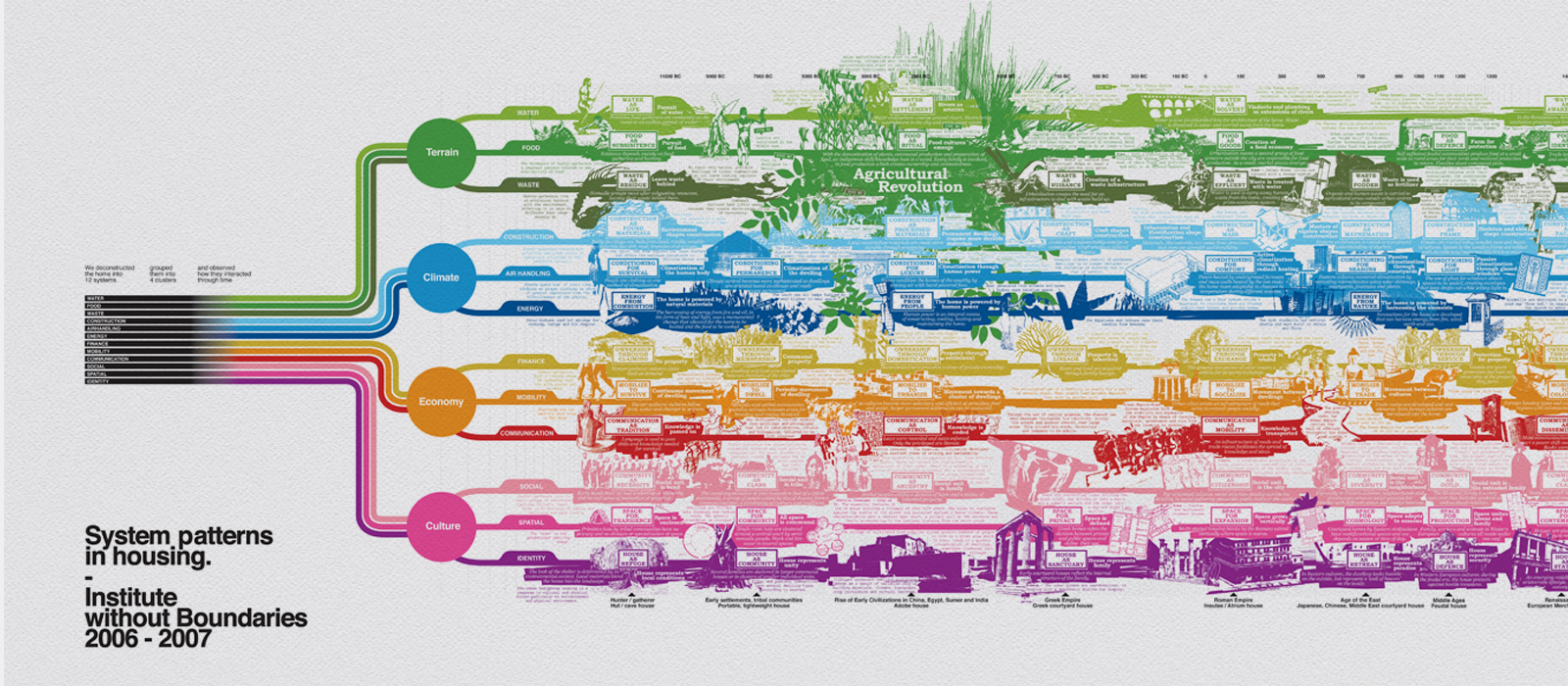World House Systems Timeline & the Systems Home Report
Overview:
In Year 01 of the World House Project, the IwB partnered with the Canada Mortgage and Housing Corporation and the Harbinger Foundation to look at housing and shelter trends throughout human history and cultures. The research developed into several reports and systems diagrams exploring the social, ecological and political function of the home. The two primary reports, Systems Home Report and the World House Systems Timeline, identified 12 systems that are needed in every home regardless of location and culture: water, food, waste, construction, air handling, energy, finance, mobility, communication, as well as social, spatial and identity aspects.
__
The systems approach enables us to see what is necessary for human survival and cultural growth; it opens the door to an emerging method for housing design that integrates these systems in a variety of ways.
Project Goals:
To research and understand important historic and contemporary housing types and to develop a timeline that can serve as a tool to help develop future housing solutions that are sustainable, adaptable and evolving to users’ needs.
The project showed that a systemic approach to housing could create a universal and locally adaptable model. By understanding the common systems in all housing and focusing on the creation process of the house rather than the end product, one can design a system that people can interact with. Thus, the house can evolve and appear as users need it, responding to changes and needs in peoples’s lives.
The Systems Home Report and World House Systems Timeline show that some housing types, pioneered by humanity’s earliest cultures, have persisted to this day and have remained largely unchanged. These forms, developed by hunter-gatherer and nomadic societies, are examples of sustainable, well-strategized solutions to cultural and environmental needs. The history and experience of all people, from all cultures and time periods, can inform modern housing design.
The report and timeline explore the history of housing in order to understand how our conceptualization of home has influenced the design of the house through time. The timeline is not intended to be a comprehensive history of housing design, nor is it intended to provide a linear or progressivist viewpoint. Rather, it identifies trends in housing and explores the impact of worldviews and cultures of different times and places. The report and timeline examine twelve systems, from construction to identity, and map out significant, related trends while telling a story of how dwellings have evolved over time.
The IwB approaches the home as a ‘system of systems’, striving for a holistic view of design in housing. Through our research, the home can be understood as it is shaped by system innovations related to location, purpose, form, and ideas, manifesting themselves as systems innovations within the home.
The timeline can be read horizontally, as an evolution, and vertically, demonstrating integration of the systems. However, the historical skeleton of horizontal evolution and vertical integration does show hierarchy of systems within specific housing types. Four clusters of three systems were understood to be closely influencing each other over this historical perspective. These observations allowed us to synthesize the design process of dwelling into four questions that summarized our observations about the home: How does my home deal with terrain? How does my home deal with climate? How does my home deal with its economy? How does my home deal with its culture? We found that the developments in one system often initiated developments or alterations in another. The interplay between systems creates unique ‘push-and-pulls’ of influence. We determined that the design of the home should recognize these interactions and interdependencies, working towards system integration that will capitalize on and make apparent these relationships. The Systems Home Report and World House Systems are meant to be used as tools to discuss and create new systems patterns in housing innovation. Throughout the academic year, the IwB students, staff and faculty conducted many other projects exploring the World House Systems, including two major charrettes. These are featured below
World House 01 Year Highlights:
Marotta Charette
January 2007
A special project charrette looking at a private residence in Scarborough belonging to the Marotta Family.
The Marottas needed to accommodate their growing family of four. They needed a larger living, dining and kitchen and family room space on the ground floor by either adding space over the garage or alternatively by adding a second floor and rearranging the ground floor.
The charrette was an exercise between IwB students and the Marottas, exploring how the world house systems could be implemented in a real life case.
CMHC Accessory Living Unit Charrette
March 2007
In celebration of the College’s 40th anniversary, the IwB students teamed up with the GBC Architectural Technology students to design a 400 sq ft living space that could be placed in laneways, on rooftops or in suburban backyards.
This charrette was a central idea formulating event that led the IwB team to develop and prototype the Canühome, which premiered at the Green Living Show in 2008.
Project Credits:
Evelyne Au-Navioz
Gavin Baxter
Kar Yan Cheung (timeline project lead)
Liz Huntly Cooke (report project lead)
Reema Kanwar
Jennifer Lee
Thomas Lommee (timeline project lead)
Rich Macintosh
Gary Moloney
Heidi Nelson (report project lead)
Carmen Paz Rivera
Giorgiana Penon
Sarah Tranum
Garth Tweedie
Perin Ruttonsha
Photo credits:
IwB students, staff and faculty
Project tags:
World House Project, 12 systems in housing, World House Systems Timeline, Systems Home Report, housing history, systems of home
“The capacity to design our future is informed by an understanding of how we have designed our past.”
– World House Systems Timeline, text excerpt 2007

